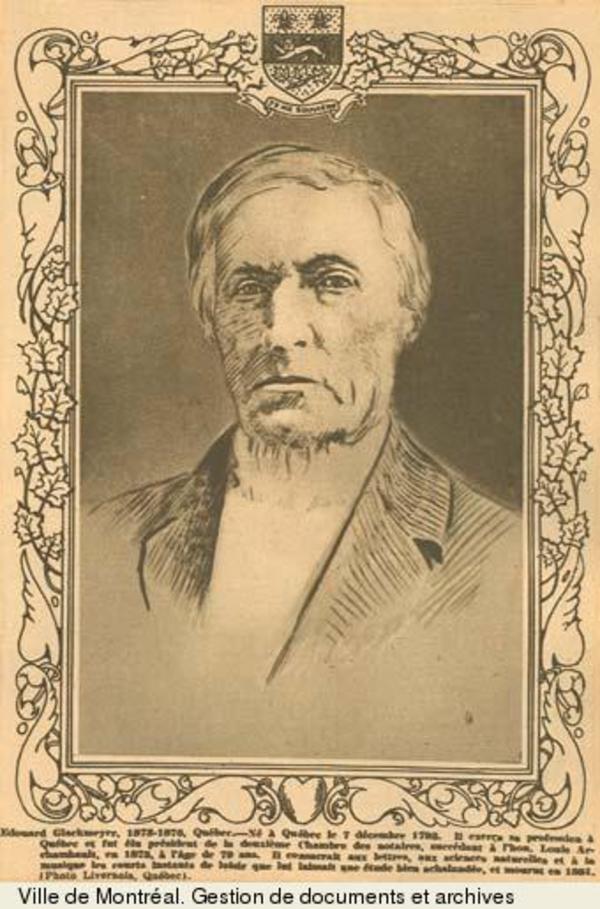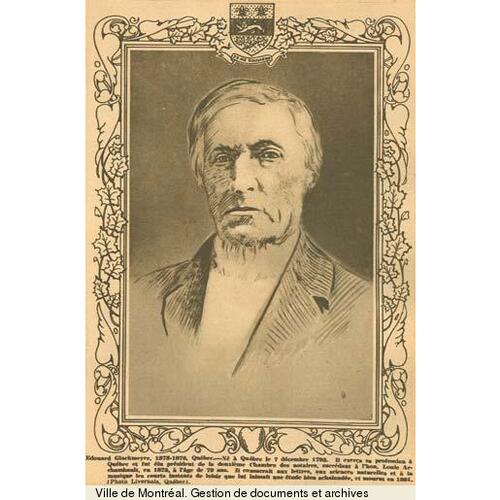
Source: Link
GLACKMEYER, LOUIS-ÉDOUARD, notary and municipal councillor; b. 7 Dec. 1793 at Quebec City, son of Frédéric-Henri Glackmeyer*, a music teacher, and Marie-Anne O’Neil; d. 9 Feb. 1881 at Quebec.
Louis-Édouard Glackmeyer’s father, a native of Hanover (Federal Republic of Germany), came to Canada in 1776 as bandmaster of a regiment of auxiliary troops of Brunswick and Hesse. His mother was the sister of Jean-Baptiste O’Neil, the well-known verger of the cathedral at Quebec who was famous for the pranks and practical jokes recounted by Louis-Honoré Fréchette* in his Originaux et détraqués (Montréal, 1892). Louis-Édouard Glackmeyer studied at the Petit Séminaire de Québec and on 13 Dec. 1815 was admitted to the profession of notary. Employed in 1815 as an assistant in the office of the law clerk of the crown, it was not long before he grew sick of the minutiæ of the bureaucracy; a few months later he opened his own office on Rue Saint-Pierre, in Quebec.
When George IV died in 1830, James Stuart*, the attorney general of Lower Canada, maintained that all public officers and all members of the liberal professions must renew their commissions and pay the same charges as were required when they were originally granted. During the 1831 session Glackmeyer complained to the assembly; shortly thereafter the house decided to call for Stuart’s resignation. “He was accused of certain acts committed during the election at William-Henry [in 1827], the unwarranted collection of certain fees for the renewal of notarial commissions, and practices aimed solely at increasing his emoluments. . . .” Lord Aylmer [Whitworth-Aylmer*] suspended Stuart in 1831, and Lord Goderich, the colonial secretary, permanently relieved him of his office in 1832.
On 7 July 1840 Roger Lelièvre chaired a meeting of 25 notaries of the Quebec region who founded the Association des Notaires du District de Québec. The principal aims of the association were to attend to all the profession’s concerns from the point of view of both the members and the public, and to supervise the studies of clerks aspiring to the profession. A committee of seven, including Glackmeyer, was instructed to draft the association’s rules; however, as things did not go to his liking, Glackmeyer resigned.
When three boards of notaries for Quebec, Montreal, and Trois-Rivières were set up by law in 1847, Glackmeyer at first expressed some doubts about the outcome but finally supported this development. Through this law, the boards obtained by royal sanction powers to appoint, reject, and discipline their members themselves. On 20 Sept. 1847 Glackmeyer was appointed syndic of the Quebec Board of Notaries. At the elections for the second triennium (1850–53), he was chosen president of this board. In 1851, when an application was made for amendments to the statute relating to the notarial profession in Canada East, Glackmeyer was summoned before a committee of the Legislative Assembly concerned with notaries’ fees. In his testimony, Glackmeyer affirmed that the majority of notaries considered the act permitted the boards to fix maximum, but not minimum, fees. According to him, such a regulation could only operate to the advantage of the profession, but it would not prevent notaries from working for a mere song.
In spite of the hostility being roused by the measure, Glackmeyer expressed his approval of an act adopted in 1860 which the attorney general for Canada East, George-Étienne Cartier*, championed. The act regulated everything related to certificates given by the registrars and provided for the method of cancelling mortgages, for the registration of proxies, and for the building of safety vaults in registry offices. In addition, the act ordered the compiling of a land register for the whole province and the renewal, once the register was completed, of all titles involving mortgages. That year, the Quebec Board of Notaries, with Glackmeyer as president, rejected a bill then before the Legislative Council to have all notarial acts countersigned by witnesses. Despite these protests, the council adopted the measure.
By 1862, as a result of the passing of the 1847 and 1859 laws permitting the creation of new boards of notaries, these institutions had increased in Canada East from three to ten. The admission examinations, which varied from one board to another, allowed almost anyone to become a notary. Furthermore, each district had its own regulations, rates, and procedures. In 1869, in order to clear up some of the confusion, notary Louis Archambeault, of the Montreal board, introduced a bill to create a single board of notaries as well as to fix the number of notaries and their place of residence. This last point aroused sharp opposition; Glackmeyer saw in it an attack on the freedom of the individual to choose his profession and to practise it in the setting of his choice. Archambeault modified his bill along these lines and it was adopted in 1870; thus a single board of notaries was created for the province of Quebec.
At the election for its first triennium on 5 Oct. 1870, Glackmeyer was chosen vice-president of the Provincial Board of Notaries. In 1873, at the elections for the second triennium, he became president. He was re-elected for a second term in 1876 but resigned because of advanced age. In his final report, Glackmeyer stressed the efforts made by the board to set stricter examinations for the admission of candidates and thereby improve the reputation of the profession throughout the province. He declared himself opposed to a statute reducing the period of training for students from four to three years. He had been the first to suggest a list recording the names and addresses of all notaries practising in the province of Quebec. In 1876, when he retired, 756 notaries in Quebec were on record.
On 6 Aug. 1822, at Quebec, Louis-Édouard Glackmeyer had married Marie-Henriette, the daughter of Étienne-Claude Lagueux, a rich Quebec merchant who long represented Northumberland County in the Lower Canadian House of Assembly. Thus Glackmeyer was soon involved in the great political discussions of the day and closely connected with the Bédards and the Nelsons. He even had fleeting inclinations from time to time to stand for election: in the Saguenay, or in Montmorency, or in Quebec County. He supported Wolfred Nelson* when the latter broke with Louis-Joseph Papineau*, but rejoined Papineau in 1848 and fought with him for the end of the union of the two Canadas. According to a letter in Le Canadien in 1848, it was at this time that he thought of standing in Quebec County. But Glackmeyer rapidly abandoned politics. He was, however, a member of the Quebec City Council from 1833 to 1845 and from 1854 to 1856, representing in turn the wards of Saint-Charles and Saint-Pierre. He was also municipal assessor for the city in 1833, then one of the justices of the peace in charge of municipal administration from 1836 to 1840.
A more enduring passion was music. He played the flute in a quartet directed by Chief Justice Jonathan Sewell*, and later he was president of the Septette Club, which was formed in 1857 and included his sister Angélique-Henriette Glackmeyer, the notary Chavigny de La Chevrotière, Alfred Paré, Archibald Campbell*, and the three Pfeiffer brothers. Glackmeyer lived in turn at Quebec, La Canardière, Charlesbourg, and Beauport. At Charlesbourg, where he owned a rural property, he could give free rein to his interest in botany, a science about which he was well informed. From 1844 to 1859, at Beauport, he made numerous meteorological observations, recording them in a book still extant in the Public Archives of Canada.
Louis-Édouard Glackmeyer did not move in society; and he seldom left his office on Rue Saint-Pierre, with its large clientele. He was even considered by his contemporaries to be somewhat eccentric; but his goodness and sound qualities earned him the confidence and respect of his colleagues and fellow citizens.
Arch. du séminaire de Chicoutimi (Chicoutimi, Qué.), Fonds Provancher, Ernest Gagnon, “Notes sur le notaire Glackmeyer”; Lettres de L.-É. Glackmeyer. PAC, MG 30, D1, 14; 18; MG 24, I94. “Mémoire sur la partie occidentale du Canada, depuis Michillimakinac jusqu’au fleuve du Mississippi,” BRH, 26 (1920): 25. P.-V. Charland, “Notre-Dame de Québec; le nécrologe de la crypte ou les inhumations dans cette église depuis 1652,” BRH, 20 (1914): 305. Le Jeune, Dictionnaire, II: 666. P.-G. Roy, Fils de Québec (4 sér., Lévis, Qué., 1933), III: 56–58. Georges Monarque, Un général allemand au Canada: le baron Friedrich Adolphus von Riedesel (Montréal, 1946), 143–45. J.-E. Roy, Hist. du notariat, II–IV. P.-G. Roy, La famille Glackmeyer (Lévis, 1916). André Vachon, Histoire du notariat canadien, 1621–1960 (Québec, 1962), 79–155. P.-B. Casgrain, “Une autre maison Montcalm à Québec (1759),” BRH, 8 (1902): 337. La Musique (Québec), I (1919): 74. P.-G. Roy, “La famille Glackmeyer,” BRH, 22 (1916): 195–205.
Cite This Article
Claude Vachon, “GLACKMEYER, LOUIS-ÉDOUARD,” in Dictionary of Canadian Biography, vol. 11, University of Toronto/Université Laval, 2003–, accessed December 30, 2025, https://www.biographi.ca/en/bio/glackmeyer_louis_edouard_11E.html.
The citation above shows the format for footnotes and endnotes according to the Chicago manual of style (16th edition). Information to be used in other citation formats:
| Permalink: | https://www.biographi.ca/en/bio/glackmeyer_louis_edouard_11E.html |
| Author of Article: | Claude Vachon |
| Title of Article: | GLACKMEYER, LOUIS-ÉDOUARD |
| Publication Name: | Dictionary of Canadian Biography, vol. 11 |
| Publisher: | University of Toronto/Université Laval |
| Year of publication: | 1982 |
| Year of revision: | 1982 |
| Access Date: | December 30, 2025 |



